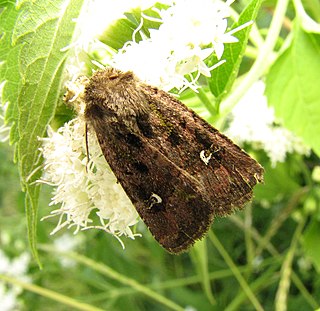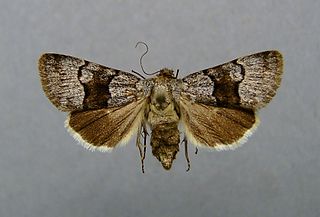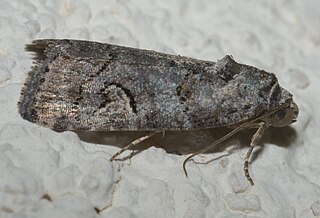
Apamea is a genus of moths in the family Noctuidae first described by Ferdinand Ochsenheimer in 1816.

Acontiinae is a subfamily of bird dropping moths in the family Noctuidae. There are more than 50 genera and 430 described species in Acontiinae, found worldwide in temperate and tropical climates.

Amphipyrinae is a subfamily of owlet moths in the family Noctuidae. There are more than 50 genera and 210 described species in Amphipyrinae, although the classifications are likely to change over time.

Hadenini is a tribe of cutworm or dart moths in the family Noctuidae. There are more than 140 genera and 1,000 described species in Hadenini, found worldwide.

Abagrotis is a genus of moths of the family Noctuidae.

Acontia is a genus of moths of the family Noctuidae. The genus was named by Ferdinand Ochsenheimer in 1816. Eusceptis, Pseudalypia and Spragueia are sometimes included in the present genus, but here they are tentatively treated as different pending further research. Many species of Tarache were also once placed here.

Euxoa is a genus of moths of the family Noctuidae raised to Genus by the German entomologist, Jacob Hübner. The Genus is mostly confined to dry and semi dry areas in the Northern Hemisphere. There 130 species in Eurasia, a few in Africa, and 175 in North America. There are no species in the Genus in South-East Asia or in Australia. In North America, most species are found in Western regions. Of the North American species, 4 are endemic to Mexico. There is one species recorded from Chile, but this may be a mislabeled specimen. In real terms, species numbers do not equal species abundance. Some areas with few species have large numbers of the ones that do live there.

Lacinipolia is a moth genus in the family Noctuidae.

Leucania is a genus of moths of the family Noctuidae first described by Ferdinand Ochsenheimer in 1816.

Lithophane is a genus of moths of the family Noctuidae. They spend the winter as adults. Some species are capable of feeding on other caterpillars or on sawfly larvae, which is rather uncommon among Lepidoptera.

Orthodes is a genus of moths of the family Noctuidae.

Polia is a genus of moths of the family Noctuidae described by Ochsenheimer in 1816.

Ponometia is a genus of moths of the family Noctuidae. The genus was erected by Gottlieb August Wilhelm Herrich-Schäffer in 1868.

Sympistis is a genus of moths of the family Noctuidae. The genus was erected by Jacob Hübner in 1823.

Tarache is a genus of moths of the family Noctuidae erected by Jacob Hübner. It includes most former New World Acontia species. Lepidoptera and Some Other Life Forms and The Global Lepidoptera Names Index report this name as a synonym of Acontia.
Noctuini is a tribe of owlet moths in the family Noctuidae. There are at least 520 described species in Noctuini.

Triocnemidina is a subtribe of owlet moths in the family Noctuidae. There are about 16 genera and at least 30 described species in Triocnemidina.

Chamaecleini is a tribe of bird dropping moths in the family Noctuidae. There are about 9 genera and 14 described species in Chamaecleini.

















